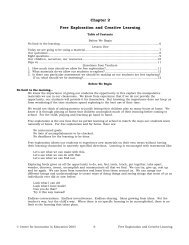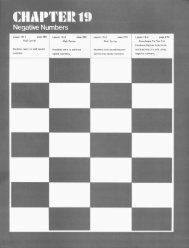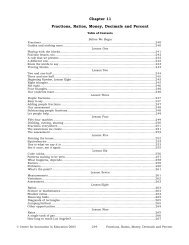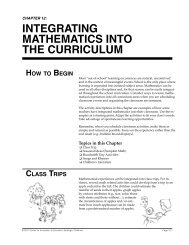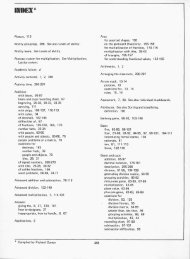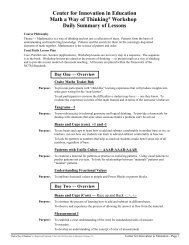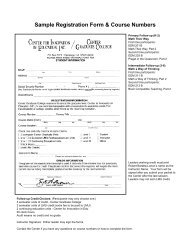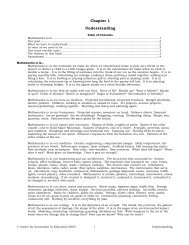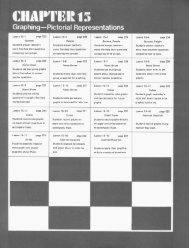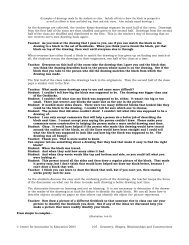PLACE VALUE MAtEriALs - Center for Innovation in Education
PLACE VALUE MAtEriALs - Center for Innovation in Education
PLACE VALUE MAtEriALs - Center for Innovation in Education
Create successful ePaper yourself
Turn your PDF publications into a flip-book with our unique Google optimized e-Paper software.
Chapter 11: Place ValueNote: Mathematics Their Way, (Ch.12) says to read amount of materialson the place value board with“and” (two zurkles and three).This is mathematically <strong>in</strong>-correct.“And” signifies a decimal po<strong>in</strong>t.The correct way to read the amountis “two zurkles, three.”Introduce Addition and Subtraction on thePlace Value BoardMaterials: Place value boards (MTW, p. 364); manipula tive materials(e.g., Unifix cubes or beans and portion cups)Be<strong>for</strong>e beg<strong>in</strong>n<strong>in</strong>g: Review how to use the place value board. The group<strong>in</strong>gs(e.g., Zurkles) are placed on the blue side and the one's are placedon the white side. If the children use Unifix cubes, they snap the cubestogether <strong>in</strong>to a stick be<strong>for</strong>e they place them on the blue side. If they usebeans, they place the group<strong>in</strong>g of beans <strong>in</strong> a cup and move the cup tothe blue side.Addition: Beg<strong>in</strong> by add<strong>in</strong>g one object. Expla<strong>in</strong> to the children that eachtime you say “plus one”, they add a cube (or bean) to their place valueboard. Once the mate rial is added to the board, the whole class saysthe number. The group cont<strong>in</strong>ues to add to the largest two-digit numberpossible, regroup<strong>in</strong>g whenever necessary. For <strong>in</strong>stance, <strong>in</strong> zurkles(group<strong>in</strong>gs of four), the largest number would be three zurkles andthree.Subtraction: Start with the largest two-digit number pos sible <strong>in</strong> thegroup<strong>in</strong>g. Ask the children to subtract one object at a time until theyreach zero — regroup<strong>in</strong>g when ever necessary.Extension: Add or subtract by two or three objects at a time.Random PracticeIt is important that children have opportunities to ran domly addand subtract.Build <strong>in</strong>g NumbersMaterials: Beans and cups or Unifix cubes; place value boardTell the children a number to build on the place value board (e.g.,2 zurkles, three). Then tell them a new number (e.g., 3 zurkles, 2).The children build the new number on the place value board withmaterials. Repeat the process several times.Observation: Observe how the children f<strong>in</strong>d their an swers. Do somechil dren clear their boards every time they build a new number? Doothers add on or sub tract the appro pri ate objects? Ask the childrento expla<strong>in</strong> how they made the new number. Ask the children if theyth<strong>in</strong>k the new number is larger or smaller than the previous number.Ask them to expla<strong>in</strong> their answer.Add or Sub tractTell the children a number to build on their place value board. Nowask them to add or sub tract a cer ta<strong>in</strong> number of beans.Observation: Watch to see if the children can regroup when it isnecessary.Page 11.8© 2011 <strong>Center</strong> <strong>for</strong> <strong>Innovation</strong> <strong>in</strong> <strong>Education</strong>, Saratoga, Cali<strong>for</strong>nia




